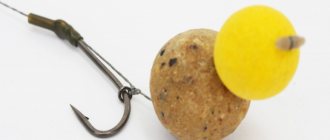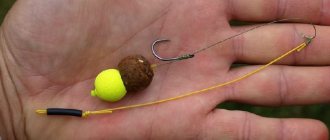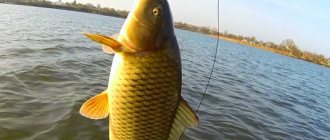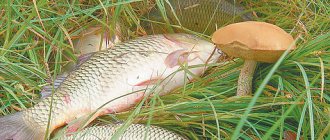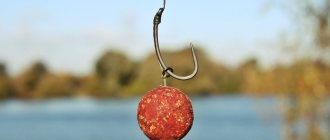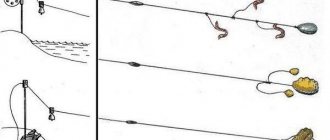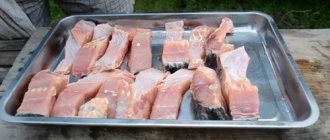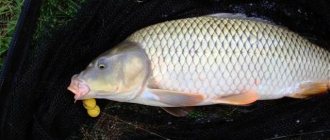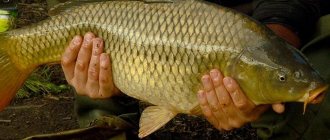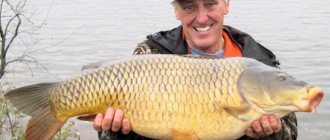Yuri 07/23/2020 1490
Experienced fishermen are interested in trophies of a certain type, as a result of which fishing becomes narrowly focused. Catching carp with boilies involves trophy fishing, since this type of bait simply cuts off small fish. Carp fishing has successfully adopted the technique of carp fishing with boilies. Fishing fishermen are increasingly using this strategy in the process of planning their next fishing session.
When and where do you catch carp with boilies?
- They catch carp with boilies from early spring until late autumn, until the reservoir is covered with ice.
- The recommended time of day for fishing with this type of bait is dawn and sunset; no fish are caught at all from one to three in the morning.
- The carp is found only on large rivers. You can fish this way in places where the river flow is slow.
- The fishing place should be chosen closer to the carp’s beds; he hides where underwater holes are adjacent to shallows. Loves wild places with snags at the bottom.
- You should not look for it: in small rivers, and also where pike live. These two types of predators do not mix well together.
Boilies for carp
Boilies are considered one of the best baits for carp. They got their name from the word boil, because. prepared by boiling. Typically, boilies are fairly large balls with aromatic contents.
Since they do not belong to the standard diet of the carp, a certain amount will definitely have to be spent on preliminary feeding of the fish, allowing them to try new food. Boilies are convenient because, due to their size, they are not suitable for small fish; they simply cannot swallow them.
Divided into:
- Homemade, made by yourself at home.
- Purchased, purchased in specialized stores.
And:
- Floating (not boiled, but dried in the microwave to give lightness and buoyancy).
- Neutral.
- Sinking (these need to be boiled, then be sure to freeze).
All types of boilies have contents with different smells and tastes:
- Animal origin (made from bone and fish meal, mixed with other ingredients).
- Vegetable origin (base – corn flour or other, with fruity odors).
There are fillings with other flavors: onion, garlic.
Carp bait
You can not only purchase boilies ready-made in the store, but you can also easily make them yourself. This will allow you to save a lot, since branded attachments can be expensive, but they will be made according to a standard and simplest recipe. We'll tell you how to make boilies at home that will be equally catchy on the river and in the lake.
Many fishermen have their own favorite recipes for preparing boilies, which are especially effective on certain bodies of water. You can easily prepare catchy boilies, which we will tell you how to make in this article .
- Pour one and a half kilograms of corn, rice or wheat flour into a large container.
- A kilogram of milk powder must be added to the resulting mixture.
- Beat in 10 chicken eggs, then mix with a whisk or mixer.
- Various flavors and dyes are added to the whipped mass.
- Knead the dough until it sticks to your hands.
- Make small balls from the dough, then cook them in boiling water for 3 minutes.
- Floating boilies are processed in the microwave for several minutes.
Homemade boilies cooked or processed in the microwave must be dried on a napkin or towel and then stored in the refrigerator. On the Internet you can find various ratings for 2016−2018, which are extremely catchy.
Which boilies are better
The best boilie size for carp is from 20 to 25 millimeters in diameter, for hunting large prey. If a smaller fish suits you, then the bait should be smaller - from 18 to 20 mm in diameter. Round shape is an optional requirement. It is believed that a square-shaped bait is more suitable for feeding on the bottom.
The color can be any: red, orange, yellow, less often blue, it has no meaning and does not affect the success of fishing. The choice of color depends only on the personal taste of each fisherman and the food coloring he uses.
Which boilies for carp to choose
At first glance, it may seem to a beginner that choosing suitable boilies is not easy, but in fact there is nothing difficult here. The main thing is to know what points to pay attention to so as not to make a mistake with your purchase.
Types of boilies for catching carp and carp
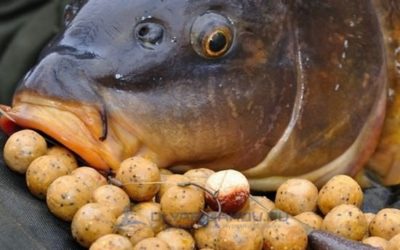
Boilies are divided into:
- floating and sinking;
- dusty, or soluble, and dry, or boiled.
Sinking boilies are most often used. After casting, they lie on the bottom and do not alarm the fish, as they remind them of their natural food . Floating boilies can be used when carp and carp are feeding near the surface. But such bait looks unnatural, so it is mainly small individuals that fall for it.
Dusty boilies begin to dissolve immediately after entering the water, emitting a trail of turbidity, which attracts fish well . The disadvantage of such a nozzle is that you need to recast more often to replace it with a new one. Dry boilies, in turn, can work on the bottom for a very long time.
Boilie size
Typically round boilies with a diameter of 8 to 30 mm are used. Balls with a diameter greater than 24 mm, as a rule, are used only for supplementary feeding . Boilies with a diameter of 8 to 24 mm , respectively, are used as bait .
- Balls up to 1.5 cm are well suited for catching small and medium-sized carp and carp , as well as in situations where the fish are inactive. One of their important advantages is that they retain their taste and smell longer than larger ones, since the ball heats and cools much more evenly during cooking.
- Boilies with a diameter of 1.5 cm, in turn, are the best option for catching trophy fish . They are also suitable for hunting medium carp or carp if it is active on the day of fishing. As you know, the mouth rejoices at a large piece. Attracting a trophy specimen with a large boilie is usually much easier than with a small one.
Small boilies can be used as bait, and large boilies can be used as bait . By collecting small balls from the bottom, the fish will stay at the fishing point longer.
Color
The color of the boilie usually does not play a big role. The most commonly used colors are yellow, red and purple. For fishing in muddy water, white or light yellow boilies are best suited, as they will be more visible to the fish in such a situation.
Taste
By smell, all boilies can be divided into three main groups:
- fruit - best suited for fishing in the warm season , when the water is well warmed up;
- fish - a good option for fishing in spring and autumn , in cold water;
- spicy - they can be used both when fishing in warm and cold water.
Dips
To make the boilie even more attractive to carp and carp, before casting the rig, you can dip it in a special flavor for bait - dip.
Reference! After deepening, this bait acquires a distinct, attractive smell that the fish will find difficult to resist.
The dip allows you to highlight the bait on the hook among the many bait boilies lying on the bottom. This makes the carp much more likely to find it faster and want to try it.
How to choose effective boilies when purchasing
Ready-made boilies can be purchased online, on specialized websites, and in stores where they are presented in an assortment. The most popular brands recommended by fishermen are Richworth and Mainline.
The products of both companies are made on the basis of scientific research, with knowledge of the taste characteristics and preferences of carp. Factory-made boilies are varied in composition, shape, color, and smell. They can sink, float on the surface of a reservoir, crumble, or create turbidity.
The choice is difficult and each fisherman has his own preferences. No one gives definite advice; you will have to experiment and use various baits, identifying the most effective ones for a particular reservoir.
Buying boilies in a store
Mainline boilies
Boilies in the store are much more attractive for carp, as they are produced based on tests and knowledge of ichthyologists about carp. We recommend buying 2 brands:
- Boilies produced by the Richworth brand. The boilie kit includes a special needle for piercing the boilie and securing it with a stopper.
- Mainline boilies are baits with a wonderful fruity and spicy smell. The range includes crumbling, durable, floating, sinking and cloud-creating boilies. You can buy them through online stores.
When buying store-bought boilies, ask anglers which brands give good results in your region. We recommend that you first buy boilies and only then, based on personal experience, you can try to make them yourself.
Making your own boilies
You will need a saucepan, a large board for rolling boilies, and vegetable oil (on your hands so that the dough does not stick). Despite the variety of recipes, the technology for making them is the same for everyone.
- Step 1. Grind the cereals using a coffee grinder.
- Step 2. From all the necessary ingredients, knead a stiff dough.
- Step 3. Roll out sausages on a board, cut them into equal pieces, and form them into balls. If the dough does not roll and falls apart, you can add wheat gluten.
- Step 4. The resulting products are boiled for about 2 minutes in boiling water. Floating boilies are cooked in the microwave. It's done like this; several ready-made balls are placed in the oven. The “Grill” mode is set for 2 minutes. At the end, the boilies are inspected: if among them there is not a single one that is slightly burnt, then the bait is dried for an additional 15 seconds.
- Step 5. The boilies are dried for several days. To dry, you can put the finished balls on a thread and hang them where they will not be accessible to birds.
The simplest recipe for any time of year:
Mix semolina or corn grits (200 grams) with birdseed (200 grams), grind, add three types of flour: soy, bone and fish in equal proportions, so that the total weight is 450 grams, pour in sunflower oil with flavor 10 ml per 1 kg mixture, add spices: cumin, garlic, cinnamon. Eggs are taken at the rate of 1 egg per 100 grams of dough. Add food coloring.
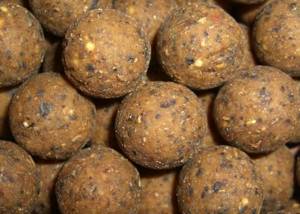
Ingredients:
- Bird food 200 grams,
- Semolina or corn grits 200 grams.
- Soy flour 200 grams.
- Bone meal 100 grams.
- Fishmeal 100 grams.
Recipes for boilies for carp
Manufacturers of fishing baits offer a wide range of boilies for carp. However, if you want to concentrate specifically on this inhabitant of reservoirs, you can make homemade boilies, taking into account the carp’s predilections.
Here is a basic recipe from which you can make variations:
- corn flour – 20%;
- roasted soybean flour – 15%;
- semolina – 25%;
- milk powder – 10%;
- pea flour 9%;
- crushed roasted sunflower seeds – 11%;
- eggs – 2-3 pcs. per kilogram of mixture;
- flavoring;
- food coloring.
How to make a makushatnik for carp with your own hands
The following composition variations are allowed:
- It is better to replace sunflower with hemp oil and seeds in the cold season;
- on hot days, the bulk of the boilie should be corn and sunflower, the latter can be replaced with unrefined sunflower oil (with flavor);
- in reservoirs where there are a lot of fry, fishmeal is added;
- to make the boilie buoyant, crushed popcorn is added to the composition;
- Instead of semolina, it is allowed to use wheat flour;
- To strengthen the ball, add egg powder;
- carp loves berry flavors in summer, but it can change its preferences even during the day, so it’s easier not to add flavoring to the mixture, but to dip the boilie in it before casting.
In the southern regions, instead of pea flour, you can add mashed potatoes, compensating for the loose structure with semolina and egg. However, if you plan to catch carp, then this fish may not like the aroma of boiled potatoes and there is a chance of being left without a bite.
The product is prepared simply: first, all the dry ingredients are placed in a large dish and mixed by hand, then eggs are added and kneading begins, water is added in small portions to maintain the consistency. Sunflower oil, flavoring and other liquid components are poured into the finished dough, and then the mass is brought to condition.
Next, manually or using a special device, balls of the required diameter are formed and poured into boiling water. The cooking time is selected for each composition. So, a 14-mm boilie based on corn and soybeans is cooked for about 80 seconds, if the backbone of the granule is a component such as fishmeal, then no more than 40 seconds. After removal from boiling water, they are dried in the oven or under natural conditions.

This is how boilies are cooked
After making the granules, the process of bringing it to condition, in addition to cooking, can go in other ways, namely:
- they can be frozen and placed on equipment in this form so that when they get into the water they release the aroma faster;
- they can be dried in an oven or microwave to impart buoyancy.
Recipes for different seasons
- For spring: three types of flour (wheat 250 grams, fish 400 grams, rice 50 grams), bran 110 grams, corn gluten 50 grams, crushed sprouted wheat and gammarus 60 grams each, milk powder for agricultural purposes. application 60 g., necessarily sea salt 60 g., betaine HCI 25 g.
- For summer: three types of flour (wheat 350 gr., rice 150 gr., fish 200 gr.), semolina 110 gr., bran 90 gr., corn gluten 50 gr., sprouted wheat and gammarus 70 gr., milk powder for agricultural application 70 gr., sea salt or regular salt 50 gr., betaine 30 gr.
- For autumn: flour, three types (fish 400 grams, rice 150 grams, wheat 250 grams), bran 110 grams, Robin Red 70 grams, wheat germ and gammarus 70 grams each, milk powder 70 grams, betan HCI 30 grams.
Cooking sequence:
Pour together the ground cereals and flour, as well as all the other dry ingredients, mix evenly. Pour the liquid ingredients into a separate bowl and stir until smooth. Combine the dry mixture with the liquid. The resulting dough is divided, and boilies of the desired shape are formed from the pieces. Depending on the purpose (floating or sinking), boil or dry in the microwave.
To increase the fish's interest in the bait, fishermen add various stimulants to the bait: seafood and various spices, odorous additives, essence, vanillin.
Stimulants can be of natural or chemical origin. It is important not to overdo it with aromatic additives.
Chemical flavors have a high concentration of composition and therefore require careful handling. To avoid spoiling the bait with too strong a smell, carefully read the instructions for use on the bottle (usually 2-3 mg is enough for 1 kg of dough).
Main groups of additives used:
- Bone flour.
- Fishmeal (shrimp, mussel, crab) with seafood flavor.
- Spices (vanilla, garlic, cumin, coriander and others).
- Fruity scents (raspberry, apple, plum, mixed berries).
- Confectionery smells (sugar, candy).
- Oils.
Equipment for fishing for carp
Fishing for carp requires the presence of a heavy sinker so that the fish catches itself. The weight of the load is selected depending on the intensity of the current. In strong currents you will need a heavy sinker. As a rule, flat or drop-shaped weights are used.
To prevent small fish from being confused, the diameter of the boilies must be at least 2 cm. The boilies are placed on the hook using a special needle. Hair equipment is used very often. The boilies are mounted in such a way that they can withstand any current perfectly.
Well-known sports equipment is used:
- Like "Method".
- Paternoster. Very easy to knit and quite sensitive.
- Asymmetrical loop. It is possible to use a “method” type feeder.

Carp are caught until ice appears on the river. After this, the fish leaves for permanent parking areas. In the spring-autumn period, carp pays more attention to bait of animal origin. Boilies with the smell of fish have proven themselves well. Carp are especially active during the Indian summer, when it is warm outside and there is no wind.
Tackle for fishing with boilies
For catching carp, special hooks are used, with a ring and a short shank, best forged in dark colors. For large fish weighing over 5 kg, it is worth taking hooks of numbers seven and eight. The bait used in this case must be at least 18-20 mm in diameter, and for larger fish, a larger bait and a corresponding hook are taken accordingly.
The fishing line is strong, braided, the color is as close as possible to the natural one in a given body of water. The most popular leash length is from 20 to 40 cm. A sinker for a loose bottom with a thick layer of silt, a lead ball, if an “olive” is suitable for a reservoir with a flat clay bottom.
For successful self-hooking, the weight of the sinker is 80 grams or more. The rod must be durable. You can catch carp using a spinning rod or a carp fishing rod.
Fishing from a boat:
- The length of the rod will be 2-2.5 meters.
- When fishing from the shore, take a rod of 3.5 meters maximum.
- There are no special requirements for the reel, any will do.
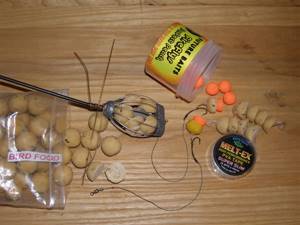
Installation of gear
When fishing with boilies, they use the hair principle of attaching bait. It consists of fixing the bait with a special needle at the tip of the fishing line - the leash, and not on the hook itself, otherwise the fish will leave when hooked.
You need to fasten it so that the hair of the fishing line starts in the middle of the hook and goes down from it. This installation is achieved using a special cambric. The required hair length is 6 cm for a boilie with a diameter of 20 mm. The hair with a needle is threaded through the bait, the needle is removed, and a fixing stop is created at the tip of the thread, preventing the bait from slipping off.
Feeding
Good bait is one of the key points of success when fishing for carp and carp. For fishing to bring good results, there must be a lot of it. Experienced carp anglers who engage in trophy fishing can use up to several tens of kilograms of it in one trip to a reservoir. This is true for summer fishing. In spring and autumn, much less bait is required .
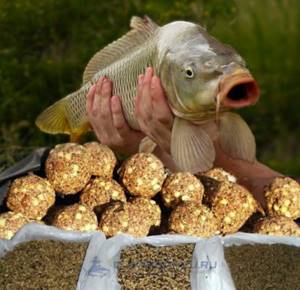
- use bait mixtures that are molded into balls;
- fishing with a feeder method, hammering bait into it;
- feed the fishing spot with boilies.
The advantage of the latter option is that small fish will not linger in the place chosen for fishing . But it is not at all necessary to feed only boilies - when a large carp or carp comes up for bait, it will displace the small things.
There are three main ways to deliver boilies to the fishing spot when fishing from the shore.
- They can be brought by boat and poured into the water in the desired area. This is a very accurate method of feeding, but for it you will also need to have a floating device.
- You can throw the bait into the water using a special device - a cobra. The accuracy of feeding suffers in this case, but it is still enough to attract fish to the equipment.
- In recent years, special radio-controlled boats for feeding boilies have become . This method allows you to deliver boilies exactly to the right place.
In the case when a mixture in balls is used for feeding, a small amount of boilies should still be delivered . The rule “what’s on the hook is what’s in the bait” for catching carp and carp is as relevant as for catching any other white fish. Boilies can be added to the mixture before making balls from it, or thrown into the water separately. This compromise option, when both bait mixture and boilies are used, is the best.
- Bait for carp and carp
- How to prepare bait for carp with your own hands
Fishing with PVA bags
Bait with a hook is placed in bags made of dissolving material, and small bait is placed around it. This creates a small feeding cloud that attracts fish.
- Sinking package. The package is mounted so that the fishing line comes out of it exactly in the center. This fishing method works like this: the sinker pulls the bag to the bottom, and the accumulated air turns the bait over, pushing the leash with the boilie out. Fine bait dissolves in water and forms a cloudy spot.
- Floating. This is done the same way, but more space is left inside for air to accumulate.
How to fish with boilies
Fishing begins with choosing a fishing spot. Carp prefers places with a sharp change in depth with a muddy bottom. The features of the bottom topography should be studied using an echo sounder. There is a corner with a quiet current, for example, a small backwater or reach. It is especially worth paying attention to the bends of the river with a clay bottom and places with fallen trees.
Now you can start feeding the carp to the chosen place. The fishing rods are not placed so as not to frighten the smart carp and create a feeling of complete security for him. This continues for about six to seven days. Feeders with complementary foods are quite heavy and it will not be possible to throw them. For this purpose you will have to use a boat. It is also the most convenient way to fish.
During fishing, the boat is fixed on two anchors to provide the necessary stability. Carp is a strong fish and will offer resistance, so it is worth foreseeing in advance all possible difficulties that will arise during the struggle between the fisherman and the catch. For the same reason, more than three fishing rods are not placed on the boat at the same time, in order to avoid tangling the gear.
The feeding area is marked with a buoy. For one day of complementary feeding, approximately two buckets of bait are spent. You should not skimp on feeding; in poorly fed places, carp does not reveal its presence.
When everything is ready, cast. We made sure that the bait fell to the bottom, now it needs to be slowly pulled along it, making several turns of the reel. Now you should make a weak toss of the bait with the rod. Often a bite occurs during the throw.
When biting a carp, you shouldn’t rush, you need to let the bait be swallowed deeper. When properly fished, the carp will cut itself. As soon as the bite occurs, you need to re-throw the gear, since carp travel in small schools. Usually the carp offers powerful resistance and strives to go into the pits, then turns around several times, changing direction, all this is accompanied by sharp jerks. Tired, the fish moves closer to the shore, where it again resumes resistance. All that remains is to get the prey out of the water.
Fishing should be done this way: after hooking, the rod is held at an angle of about 60 degrees, this will make it possible to hold the fish, preventing it from coming close to the shore. In this position, the rod absorbs shocks. The fishing process takes no more than a minute. A sufficiently exhausted carp can be brought to the shore.
Tackle for carp fishing
Boilie tackle for carp fishing is not complicated, so you can easily make it yourself or select the right components in fishing stores.
A rod for strong fish . Carp is a strong fish, and it is possible to catch specimens weighing 20 kilograms or even more. Accordingly, it is necessary to choose the right power of the fishing rod, since when hooking and retrieving, the rod will take on a huge load.
Experienced fishermen recommend fishing with the following carp rods:
- Casting - 100 grams.
- Length - 3.6−4.2 meters.
- One-piece, durable handle with a two-handed grip length.
Preference should be given to rods in which the rings are attached to high legs . This will allow you to simultaneously cast long distances, preventing rapid wear of the line.
High quality and reliable reel
The reels used must be durable and reliable. There is no fundamental difference in the type of coils.
It should only suit the angler’s preferences, providing the maximum possible casting distance .
Carp reels meet the following requirements:
- Made from durable materials.
- Size - 6000−12000.
- The friction brake is located at the rear.
- Have at least 4 bearings.
- Presence of a byrunner mechanism.
On sale you can find special reinforced reels for catching carp with boilies. If possible, we recommend that you give preference to these reinforced reels, which are strong, reliable and durable. Their only drawback is their high cost.
Fishing line and cord for carp
Monofilament or braided fishing line can be used for carp fishing. Its cross-section is chosen depending on the expected specimens of fish at the fishing site.
If possible, we recommend purchasing a thin branded strong fishing line , which will allow you to easily catch even the largest specimens.
Braided fishing line should be chosen with a thickness of 0.16 to 0.3 millimeters . Monofilament line can be used for boilies with a thickness of 0.2 to 0.4 millimeters.
Types of Fishing Hooks
It is best to use special hooks for carp fishing, the strongest and largest, with sizes from 0 to 4. A feature of such special carp hooks is the use of heavy-duty high-quality wire for their manufacture.
Additional equipment for fisherman
When catching carp with boilies, additional equipment can be used, which includes:
- Leash with thin line.
- Swivel.
- Mesh feeder or sinkers.
- Anti-twist.
- Net.
- Bite alarms.
Place and time of fishing
Often, the success of fishing depends on the correct choice of place and time of fishing. It is necessary to select certain places on the lake and river accordingly, taking into account the time of year.
In spring, fish are not so active, so it is best to go to the river on warm and sunny days , while fishing is carried out at a depth of up to 3 meters at a short distance from the shore. But in bad weather and cold in the spring, the fish almost completely stop feeding.
In summer, the oxygen content in warm water decreases; therefore, in the very heat, the fish are practically inactive. Carp can take refuge from the heat in snags, deep holes, and like to stand near springs. In rare cases, when there is an acute lack of oxygen in the water, the carp rises to the very surface. The peak feeding activity of fish occurs in the evening and morning hours . Fishing can be successful on rainy days and cloudy weather.
Autumn is the best time to catch any fish. Carp bite especially well in September and early October . But subsequently, as the temperature drops, the activity of the fish invariably decreases. In the morning and evening, carp usually stand at maximum depths. And on sunny, warm days, the fish come out to feed in shallow water areas. In late autumn, the carp lies down in wintering pits, where it falls into torpor and practically does not move or feed.
Fishing for boilies itself is not difficult . The fisherman only needs to decide how to fish. In this case, up to a dozen fishing rods can be used, which are properly equipped, the fish are pre-fed, after which baits are dropped along a deep plus, hole, or simply to great depths, and bells or other bite alarms are put on the rod. All that remains is to wait for the alarm to go off and fish correctly, not letting it go into the grass or snags, where the carp is guaranteed to break the tackle.
Blitz - tips
- Boilie boiling time: 16 mm up to 90 seconds, 18 mm up to 2 minutes, 20 mm no longer than 2.5 minutes, 22 mm no longer than 3 minutes.
- It is generally not necessary to add dyes to complementary foods. The fish doesn't care about their color.
- In spring, when the water has not yet warmed up, carp are attracted to sharp fruity smells.
- You need to catch and feed with the same boilies!
- For long casting, the maximum amount of fishing line is wound.
- Leash length when fishing on a lake: 20-25 cm. If the bottom is heavily silted or grassy, then the leash is made longer than 30-40 cm. Short ones up to 20 cm are used if the bottom is rocky or sandy, as well as for long-distance casting.
- In summer, while fishing, boilies are kept in the shade without being pulled out of the net.
- The optimal number of installed rods is from 2 to 4 at the same time.
- You can find places where fish lie by observing the water surface with binoculars, early in the morning or in the evening, when there are no ripples on the water. Look for places where large bubbles appear.
- Do not try to fish in areas with large concentrations of anglers.
- For a reservoir with a medium current, year-round boilies with a fruity aroma are suitable. For the warm season, fish ones are used.
- Boilies can be defrosted several times, only those that are free of mold. Defrosting and freezing are done in the same bag to prevent odors from evaporating.
- A floating boilie can be replaced with a cork; to do this, it is first pierced with a needle and placed in a bag with the desired flavoring.
